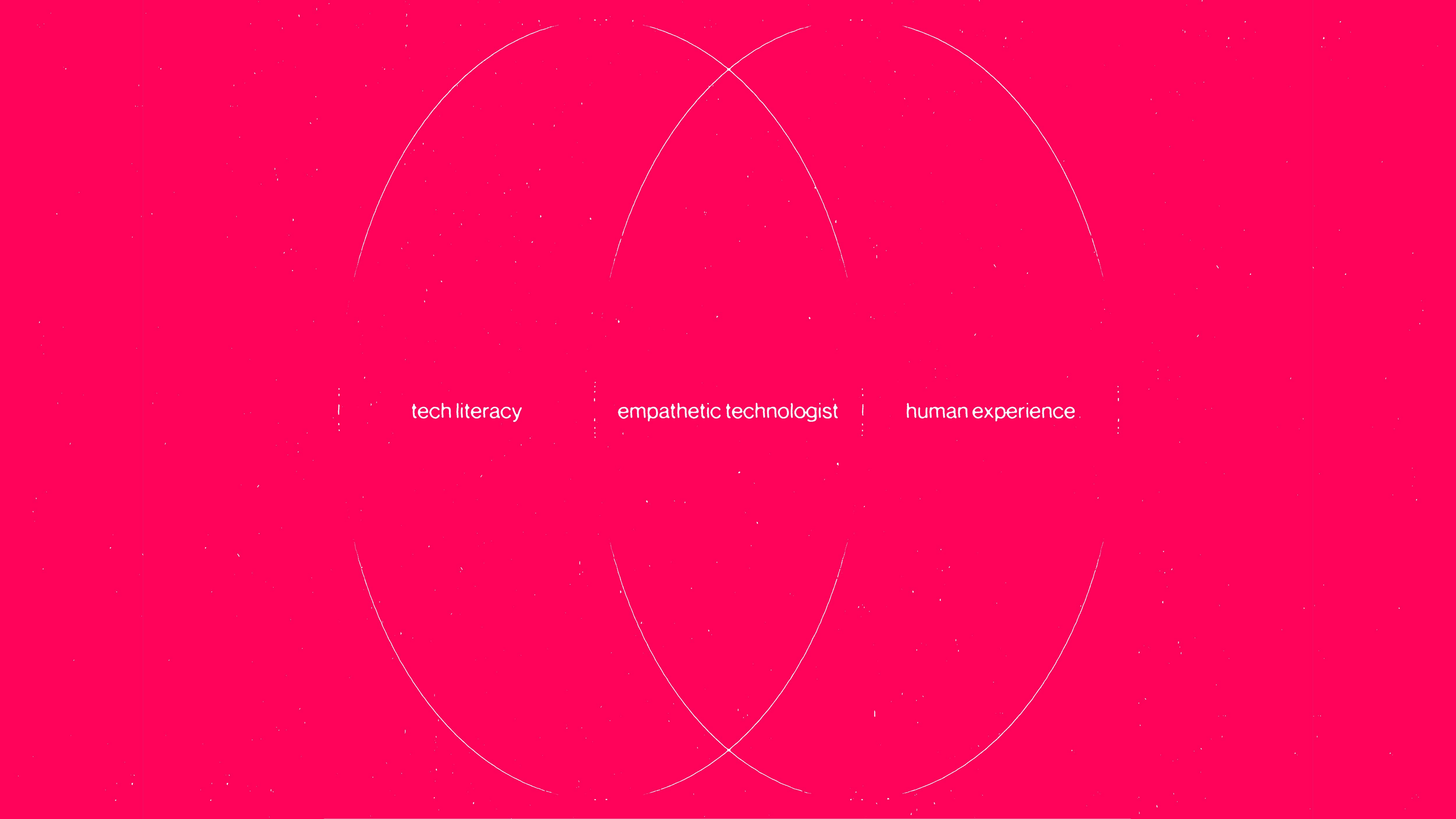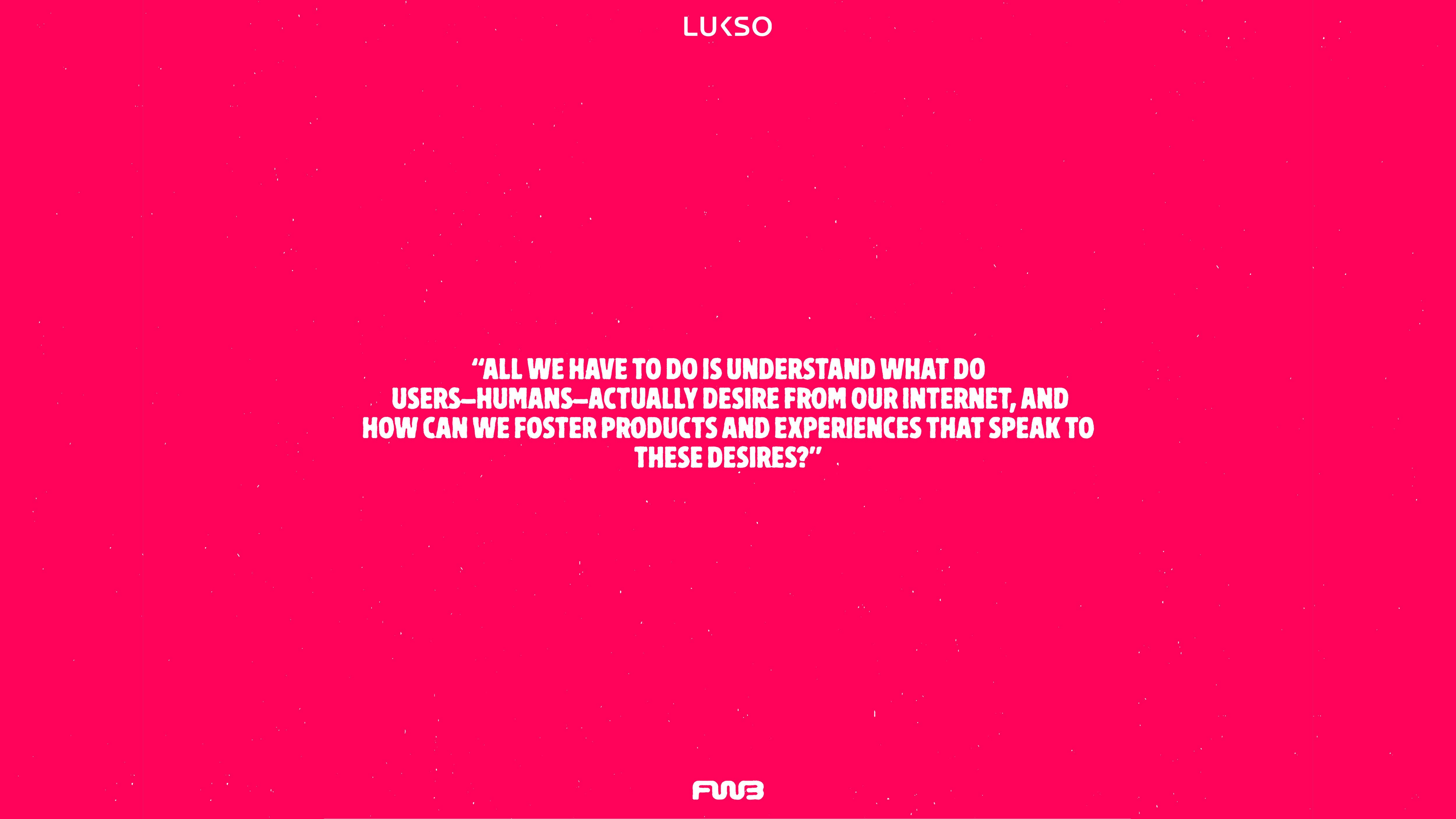- Ariel LeBeau
- Austin Robey
- David Blumenstein
- David Ehrlichman
- David Kerr
- Devon Moore
- Dexter Tortoriello
- Drew Coffman
- Drew Millard
- Eileen Isagon Skyers
- FWB Staff
- Greg Bresnitz
- Greta Rainbow
- Ian Rogers
- Jessica Klein
- Jose Mejia
- Kelani Nichole
- Kelsie Nabben
- Kevin Munger
- Khalila Douze
- Kinjal Shah
- LUKSO
- Lindsay Howard
- Maelstrom
- Marc Moglen
- Marvin Lin
- Mary Carreon
- Matt Newberg
- Mike Pearl
- Mike Sunda (PUSH)
- Moyosore Briggs
- Nicole Froio
- Ruby Justice Thelot
- Simon Hudson
- Steph Alinsug
- The Blockchain Socialist
- Willa Köerner
- Yana Sosnovskaya
- Yancey Strickler
- iz

Thu May 09 2024
Our emerging tech lacks empathy. In order for our products to speak to our human desires–not just what we want and need–then our product experiences, our technology, and our builders need to start from a place of empathy for our users.
In preparation for our collaborative partnership with LUKSO at FEST 2024, we examined our respective source materials in the form of our original insights and continuing guiding vision. Doing so surfaced a shared pillar within our commitment to building with culture-first. A more empathetic tech lies at the heart of our pursuits. In a world where the speed of our technology often frontruns user engagement, we could use a little more empathy to support wider adoption.

The internet is a portal to self-actualization
Empathetic technologists contain the rare combination of deep expertise in both users (humans) and the underlying, emerging technology. Many of us early entrants to web3 have critical knowledge on blockchain tech, but we fail to regularly integrate our deep individual and collective expertise in the human experience. We refer to this expertise when we talk about “knowing what users desire” as a gateway to building for culture.
In this context, desire refers to something we wish to have once our needs and wants have been met. If we place desire, needs, and wants within Maslov’s hierarchy of needs, desire exists at the topmost level. From here we can reframe the question of desire to a more precise question guiding our work at FWB: how can the internet be a portal to our individual and collective self-actualization?

As builders and creatives, the problem set is deceptively simple. All we have to do is understand what do users—humans—actually desire from our internet, and how can we foster products and experiences that speak to these desires?
In January, we shared our answer to this question in a web3 cultural blueprint outlining 6 pillars for using culture to drive adoption of emerging technology. We point to desire as a core user motivation. Some identify this as tokenizing culture, some see it in scenecoins, and others embrace it by building with human readable design.
In “A Blueprint for the New Creative Economies”, LUKSO outlines a future where digital identities, assets, and rights are seamlessly integrated into the fabric of the internet. This integration is not merely technical but cultural, ensuring that users can easily navigate and adopt new technologies without facing a formidable learning curve with challenging interfaces and significant fees. Enter human readable design.

Human readable design for a better internet
In order for blockchain to reach its full potential, it must be as understandable and aesthetic as it is innovative. It must have taste. LUKSO’s concept of human readable design, as articulated in “A Blueprint for New Creative Economies”, invokes an impact-driven build philosophy aligned with five design pillars:
- Clarity – users know what to do next
- Simplicity – the user journey is as direct as possible
- Consistency – users anticipate and are provided with engaging experiences
- Inclusivity – users’ unique perspectives are considered
- Empathy – users see their desires reflected in the technology

If we map these pillars against our desire for self-actualization, we emerge a framework to bridge the often cryptic nature of blockchain technology with the fluid, intuitive understanding that everyday users bring to digital interactions.
Here is our shared blueprint for empathetic web3 technology applied to a better internet, bucketing the five pillars of human readable design into pairs to align with user needs, wants and, ultimately, desires.

The Need for Simplicity and Clarity
Users often feel overwhelmed with the avalanche of new technologies. FWB member and FEST lecturer Ruby Thelot writes in a recent essay, “in the age of AI-generation, Taste will become the critical skill one has to learn to parse through the towering wave of new things that will emerge from technological acceleration.”
Taste is analogous to curating, and what is curation other than simplifying complexity. Simplifying complexity as curation–also taste–is a user behavior that predates the internet by centuries. But simplicity alone is not enough to temper the anxiety of ambiguity. A simple interface is just as likely to cause significant confusion as a chaotic UI. This is where simplicity’s counterpart clarity emerges as a critical player on the quest for self-actualization.

The Want for Consistent and Engaging Experiences
Consistency builds trust and engaging experiences create delight. We know this from our most generative human relationships. Our subconscious yearning for these kinds of relationships extends to our technology. What is more compelling than trust and delight? Product consistency and delight is critical to achieving elusive user retention and brand loyalty.
The reduction of friction is an evergreen aspiration for web3 product design. And just like every other pillar of human readable design, creating consistent, engaging experiences requires a nuanced understanding of your audience archetypes.

The Desire for Inclusivity and Empathy
We’re living through the narrative collapse of trad tech monopolies. In their relentless pursuit of mass-market dominance, software companies, hardware brands and social networks have produced anti-cultural and anti-social innovations while keeping users trapped within monopolistic, anti-democratic systems.
Yet a single, monolithic user archetype does not exist. It’s impossible to design a tech experience that will speak to every type of user. Decentralization is our next shot at utilizing technology to be the better versions of ourselves. Some might even call this designing for belonging.

Leaving the labyrinth: the LUKSO case study
A labyrinth. That’s the current state of most web3 product experiences. web3 interfaces are nearly as complex and challenging as the underlying technology, which is not so surprising considering the scale and pace of blockchain innovation. As consumer applications journey toward product-market-fit, nailing the retail interface is the current race to the top.
In adopting a human readable design for their universal profiles protocol, LUKSO has successfully transformed the esoteric into the legible. What once was a computer-centric design language, has now transformed into a customizable and highly personal experience. As users navigate their digital identities, they encounter interfaces (worlds) free of the cryptic signaling and heavy technical language commonplace for most web3 experiences. This brings true “humanness” to the blockchain experience. Human readable design continually considers the end user’s path out of the dark forest, allowing their digital interactions to guide where and how we illuminate the roadmap. This is empathetic tech.
A better internet requires the transformation of ‘users’ into ‘participants’, and redistributing power from the platforms to the people. By creating an abundance of access to these new tools and dynamic standards, LUKSO becomes an ecosystem facilitator that not only brings blockchain to its next frontier, but enables the once clunky and complex technology to become beautifully invisible, yet social and cultural at the same time. Creatives, brands, designers – even friends, can now tap into the full potential of true ownership, interoperable identities and unleash their creative force without intermediaries of the past or technical complexities.
Since its inception, LUKSO has built out its digital base layer with context. Previously siloed industries can now converge in an open, interoperable ecosystem with creativity, social interactions and culture at the core.

Sending a token to a friend by their name (rather than a wallet string of letters and numbers)

Interacting on blockchain in a couple of clicks - gasless and easy
What happens next
Culture is context. It shapes how our technology is received and perceived, influencing everything from user interface design to the overarching narratives that guide user adoption. As we shape our tech, it shapes us in return, and so forth. Our technological advancements are more than just tools; they are part of a globally distributed movement toward a more equitable and creative digital landscape. The cultural tech stack is here. The best part is we decide what happens next.
Curious about LUKSO’s Universal Profiles? Create one today or dive deeper into their technical documentation.


